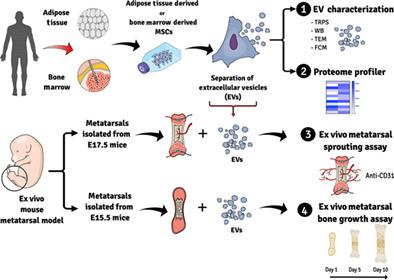当前位置:
X-MOL 学术
›
Stem Cells Transl. Med.
›
论文详情
Our official English website, www.x-mol.net, welcomes your
feedback! (Note: you will need to create a separate account there.)
Role of extracellular vesicles from adipose tissue- and bone marrow-mesenchymal stromal cells in endothelial proliferation and chondrogenesis
STEM CELLS Translational Medicine ( IF 5.4 ) Pub Date : 2021-09-04 , DOI: 10.1002/sctm.21-0107 Cansu Gorgun 1, 2 , Maria Elisabetta Federica Palamà 1 , Daniele Reverberi 3 , Maria Cristina Gagliani 1 , Katia Cortese 1 , Roberta Tasso 1 , Chiara Gentili 1
STEM CELLS Translational Medicine ( IF 5.4 ) Pub Date : 2021-09-04 , DOI: 10.1002/sctm.21-0107 Cansu Gorgun 1, 2 , Maria Elisabetta Federica Palamà 1 , Daniele Reverberi 3 , Maria Cristina Gagliani 1 , Katia Cortese 1 , Roberta Tasso 1 , Chiara Gentili 1
Affiliation

|
The secretome of mesenchymal stromal cells (MSCs) derived from different tissue sources is considered an innovative therapeutic tool for regenerative medicine. Although adipose tissue-and bone marrow-derived MSCs (ADSCs and BMSCs, respectively) share many biological features, the different tissue origins can be mirrored by variations in their secretory profile, and in particular in the secreted extracellular vesicles (EVs). In this study, we carried out a detailed and comparative characterization of middle- and small-sized EVs (mEVs and sEVs, respectively) released by either ADSCs or BMSCs. Their involvement in an endochondral ossification setting was investigated using ex vivo metatarsal culture models that allowed to explore both blood vessel sprouting and bone growth plate dynamics. Although EVs separated from both cell sources presented similar characteristics in terms of size, concentration, and marker expression, they exhibited different characteristics in terms of protein content and functional effects. ADSC-EVs overexpressed pro-angiogenic factors in comparison to the BMSC-counterpart, and, consequently, they were able to induce a significant increase in endothelial cord outgrowth. On the other hand, BMSC-EVs contained a higher amount of pro-differentiation and chemotactic proteins, and they were able to prompt growth plate organization. The present study highlights the importance of selecting the appropriate cell source of EVs for targeted therapeutic applications.
中文翻译:

来自脂肪组织和骨髓间充质基质细胞的细胞外囊泡在内皮增殖和软骨形成中的作用
来自不同组织来源的间充质基质细胞 (MSCs) 的分泌组被认为是再生医学的创新治疗工具。尽管脂肪组织和骨髓来源的 MSCs(分别为 ADSCs 和 BMSCs)具有许多生物学特征,但不同的组织来源可以通过其分泌谱的变化来反映,特别是在分泌的细胞外囊泡 (EVs) 中。在这项研究中,我们对 ADSC 或 BMSC 发布的中小型电动汽车(分别为 mEV 和 sEV)进行了详细的比较表征。使用离体跖骨培养模型研究了他们参与软骨内骨化设置,该模型允许探索血管发芽和骨生长板动力学。尽管从两种细胞来源分离的 EV 在大小、浓度和标记表达方面表现出相似的特征,但它们在蛋白质含量和功能效应方面表现出不同的特征。与 BMSC 相比,ADSC-EV 过表达促血管生成因子,因此,它们能够诱导内皮索生长显着增加。另一方面,BMSC-EVs 含有更多的促分化和趋化蛋白,它们能够促进生长板的组织。本研究强调了为靶向治疗应用选择合适的 EV 细胞来源的重要性。它们在蛋白质含量和功能作用方面表现出不同的特征。与 BMSC 相比,ADSC-EV 过表达促血管生成因子,因此,它们能够诱导内皮索生长显着增加。另一方面,BMSC-EVs 含有更多的促分化和趋化蛋白,它们能够促进生长板的组织。本研究强调了为靶向治疗应用选择合适的 EV 细胞来源的重要性。它们在蛋白质含量和功能作用方面表现出不同的特征。与 BMSC 相比,ADSC-EV 过表达促血管生成因子,因此,它们能够诱导内皮索生长显着增加。另一方面,BMSC-EVs 含有更多的促分化和趋化蛋白,它们能够促进生长板的组织。本研究强调了为靶向治疗应用选择合适的 EV 细胞来源的重要性。他们能够促进生长板组织。本研究强调了为靶向治疗应用选择合适的 EV 细胞来源的重要性。他们能够促进生长板组织。本研究强调了为靶向治疗应用选择合适的 EV 细胞来源的重要性。
更新日期:2021-09-04
中文翻译:

来自脂肪组织和骨髓间充质基质细胞的细胞外囊泡在内皮增殖和软骨形成中的作用
来自不同组织来源的间充质基质细胞 (MSCs) 的分泌组被认为是再生医学的创新治疗工具。尽管脂肪组织和骨髓来源的 MSCs(分别为 ADSCs 和 BMSCs)具有许多生物学特征,但不同的组织来源可以通过其分泌谱的变化来反映,特别是在分泌的细胞外囊泡 (EVs) 中。在这项研究中,我们对 ADSC 或 BMSC 发布的中小型电动汽车(分别为 mEV 和 sEV)进行了详细的比较表征。使用离体跖骨培养模型研究了他们参与软骨内骨化设置,该模型允许探索血管发芽和骨生长板动力学。尽管从两种细胞来源分离的 EV 在大小、浓度和标记表达方面表现出相似的特征,但它们在蛋白质含量和功能效应方面表现出不同的特征。与 BMSC 相比,ADSC-EV 过表达促血管生成因子,因此,它们能够诱导内皮索生长显着增加。另一方面,BMSC-EVs 含有更多的促分化和趋化蛋白,它们能够促进生长板的组织。本研究强调了为靶向治疗应用选择合适的 EV 细胞来源的重要性。它们在蛋白质含量和功能作用方面表现出不同的特征。与 BMSC 相比,ADSC-EV 过表达促血管生成因子,因此,它们能够诱导内皮索生长显着增加。另一方面,BMSC-EVs 含有更多的促分化和趋化蛋白,它们能够促进生长板的组织。本研究强调了为靶向治疗应用选择合适的 EV 细胞来源的重要性。它们在蛋白质含量和功能作用方面表现出不同的特征。与 BMSC 相比,ADSC-EV 过表达促血管生成因子,因此,它们能够诱导内皮索生长显着增加。另一方面,BMSC-EVs 含有更多的促分化和趋化蛋白,它们能够促进生长板的组织。本研究强调了为靶向治疗应用选择合适的 EV 细胞来源的重要性。他们能够促进生长板组织。本研究强调了为靶向治疗应用选择合适的 EV 细胞来源的重要性。他们能够促进生长板组织。本研究强调了为靶向治疗应用选择合适的 EV 细胞来源的重要性。









































 京公网安备 11010802027423号
京公网安备 11010802027423号